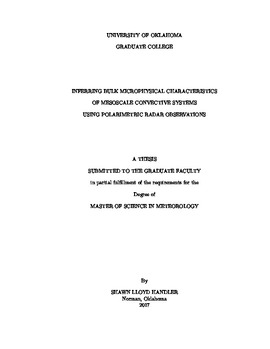| dc.description.abstract | In 2013, the network of NEXRAD WSR-88D’s were upgraded to dual-polarization. Dual-polarization allows for the identification of particle shape, size, orientation, and concentration within a radar sample volume due to the addition of new and derived radar variables which include differential reflectivity (ZDR), specific differential phase (KDP), and the co-polar correlation coefficient (RHV).
In this study, polarimetric radar observations were utilized to create high-resolution three dimensional composites to better understand bulk hydrometeor distributions and their associated microphysical characteristics within mesoscale convective systems (MCSs). A hydrometeor classification algorithm (HCA), a novel radar echo identification algorithm, and a reanalysis dataset were used to examine hydrometeor distribution changes in relation to storm lifecycle, storm structure, storm environment, geographic location, and time of year. An idealized model was also used to compare observed hydrometeor distributions to those simulated from a model by using a polarimetric radar data simulator (PRDS). This study also demonstrate how microphysical variables from a model and simulated polarimetric radar variables can improve hydrometeor classification.
Results from both the modeling and observational component indicate that graupel particles are typically the most dominant hydrometeor type within the convective region upwards of 5 km above the environmental freezing level during the developing and mature stages of MCSs. Below the freezing level, rainwater dominants, although sometimes small hail and graupel are present in the earlier stages of the MCS. Stratiform precipitation consists of small graupel concentrations within 2 km of the freezing level ~10%, whereas dry-snow aggregates are the dominant hydrometeor type closer to the freezing level, thereafter ice crystals of various orientations are more dominant near echo top. Issues regarding the melting process in microphysical parameterization are also discussed. | en_US |
